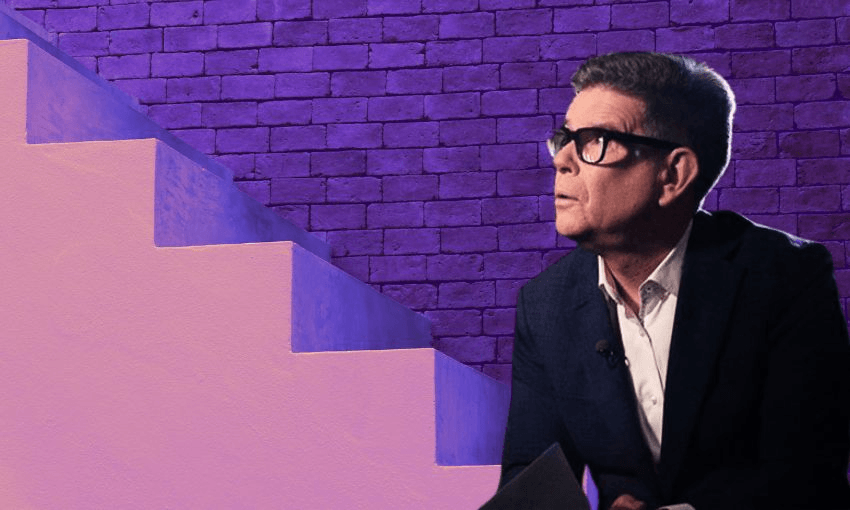TVNZ’s latest investigative series delves into true crime, and gives us an idea of where the future of the network’s news is heading.
It took two years and multiple emails from John Campbell for Mandy Molloy to feel that her daughter Rachel’s sudden death in 2022 was finally being treated seriously by police. At the end of his new series The Woman At the Bottom of The Stairs, Campbell tells Molloy the story they’ve uncovered together is that of a mother’s love. More cynically, it’s a story about the ways in which police failed a vulnerable woman.
In six 15-minute episodes, Campbell tells the story – sometimes linear, sometimes not – of the circumstances that led to Rachel’s death in May 2022. Rachel was a month away from giving evidence for her own sexual assault case – she was allegedly drugged and raped following a burglary in 2020 – when she was found dead at the bottom of the front stairs of her Mt Eden flat. Through interviews with Molloy and OIA releases, Campbell doesn’t get to the bottom of how or why Rachel died, instead uncovering how long you can ask a question before someone finally listens to you.
Rachel was counted as one of numerous New Zealanders who die every year in circumstances that are considered sudden or accidental. In the mind of her mother, Rachel’s death was anything but – though trying to convince the police of the same thing seemed impossible, or for the “too hard” basket.
In piece-to-camera segments shot from Campbell’s desk in the TVNZ office, with his Hurricanes jersey draped over his chair and Thank You cards stuck to his computer screen, he unwraps Rachel’s story. If you’re expecting the kind of big budget true crime productions Netflix offers, you’ll find something a lot more stripped back and focused on the news gathering processes in Campbell’s series.
The show has few voices – Campbell, Molloy, the TVNZ staffers pulled in to voice emails sent by police (no NZ Police officer fronted the show, and their lack of physical presence leaves a hanging shadow throughout the episodes) and Dr Jocelyn Peach, a Victim Support worker assigned to Rachel’s case. The third episode examines Peach’s involvement with the family, and how the handling of Rachel’s case eventually pushed her to leave Victim Support.
The episodes are also presented in the style of an extended news bulletin, rather than a true crime docuseries in the vein of Making a Murderer or The Staircase. This removes that weirdly exploitative feeling most Netflix productions come with, but it also feels slightly awkward at times, with some odd editing flourishes (like having Campbell’s redacted OIA documents surround his face rather than having their own frame) and segments that feel like they may have been filmed the day before release (with the ramping up of events in the final episode, this may actually have been the case).
But the series also offers a glimpse into the future of TVNZ, and a way for 1News to establish its own style of video news and “content”. With Sunday scrapped and the 1News website headed for the same fate, as is reportedly being proposed, The Woman at The Bottom of The Stairs gives TVNZ another shot at owning longform video investigations that other outlets may not have the resources for.
The “content” released so far is powered by senior journalists like Campbell, Indira Stewart and Gill Higgins, who have had years of experience in front of and behind the camera, and know their way around challenging stories.
With this perspective, Campbell also breaks down how difficult it can be to secure OIA documents, being seen as a “media risk” and fobbed off by those you’re relying on for answers, which gives the audience a better understanding of the obstacles journalists face and why some questions are left hanging. Hopefully the juniors who may be at risk of losing their jobs at TVNZ have a pathway to make more of this kind of meaningful longform news as well.
It’s taken over a year for Molloy and Campbell to tell Rachel’s story, drawn out by back and forth with NZ Police and the fact that Campbell probably has another handful of stories on the go at any given time. Once you get used to seeing a true crime-esque series presented more as a news bulletin than a high production Netflix offering, the grim reality of the story at hand sets in: a woman who had lived through terrible trauma and struggled to have her voice heard was still ignored in death.
A coronial inquest can take as long as three years to be released. It may find that Rachel did die from a tragic accident, or it may reveal something darker. For now, Molloy can at least sleep a little more peacefully knowing someone has actually listened – but maybe if the people with the most power in these instances had listened earlier, she’d already know what happened to her daughter.



